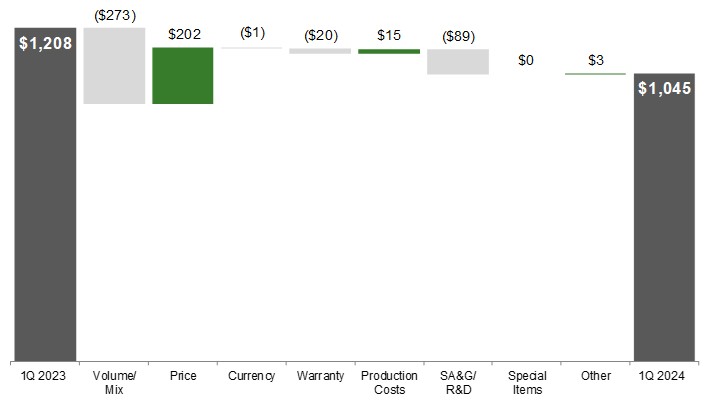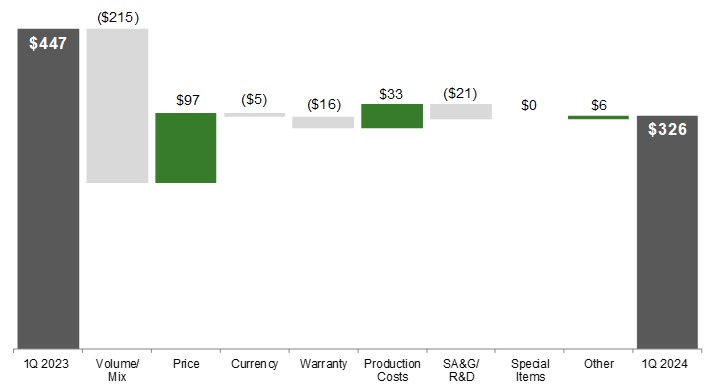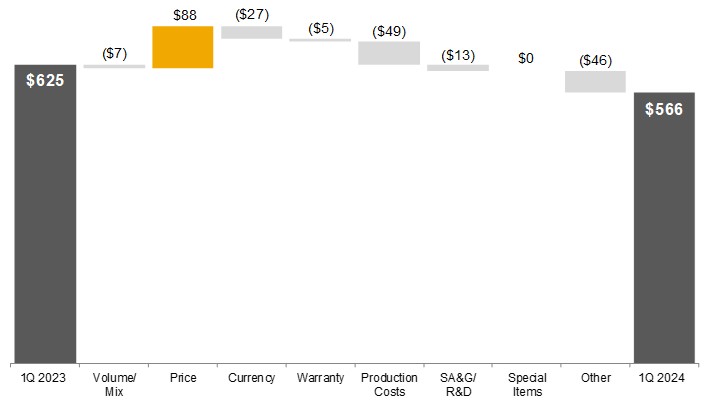Cash Flows
| | | | | | | |
| | Three Months Ended | |
| | January 28 | | January 29 | |
| | 2024 | | 2023 | |
Net cash used for operating activities | | $ | (908) | | $ | (1,246) | |
Net cash provided by investing activities | | | 1,217 | | | 760 | |
Net cash used for financing activities | | | (2,645) | | | (339) | |
Effect of exchange rate changes on cash, cash equivalents, and restricted cash | | | 16 | | | 62 | |
Net decrease in cash, cash equivalents, and restricted cash | | $ | (2,320) | | $ | (763) | |
Cash outflows from consolidated operating activities in the first three months of 2024 were $908. This resulted mainly from a working capital change, partially offset by net income adjusted for non-cash provisions. Cash inflows from investing activities were $1,217 in the first three months of this year. The primary drivers were collections of receivables (excluding receivables related to sales) exceeding the cost of receivables acquired and a change in collateral on derivatives – net, partially offset by purchases of property and equipment. Cash outflows from financing activities were $2,645 in the first three months of 2024. The increase in cash used for financing activities was due primarily to net payments of borrowings. Cash returned to shareholders was $1,714 in the first three months of 2024. Cash, cash equivalents, and restricted cash decreased $2,320 during the first three months of this year.
Key Metrics and Balance Sheet Changes
Trade Accounts and Notes Receivable – Trade accounts and notes receivable arise from sales of goods to customers. Trade receivables increased by $56 during the first three months of 2024, mostly due to a seasonal increase. These receivables increased $186, compared to a year ago, due to higher dealer inventory levels. The percentage of total worldwide trade receivables outstanding for periods exceeding 12 months was 1 percent at each of January 28, 2024, October 29, 2023, and January 29, 2023.
Financing Receivables and Equipment on Operating Leases – Financing receivables and equipment on operating leases consist of retail notes originated in connection with financing of new and used equipment, operating leases, revolving charge accounts, sales-type and direct financing leases, and wholesale notes. Financing receivables and equipment on operating leases decreased $1,066 during the first quarter of 2024, primarily due to seasonal payments, and increased $8,386 in the past 12 months, due to strong retail sales. Total acquisition volumes of financing receivables and equipment on operating leases were 16 percent higher in the first three months of 2024, compared with the same period last year, as volumes of wholesale notes, retail notes, and financing leases were higher, while revolving charge accounts and operating leases were lower compared to the same period last year.
Inventories – Inventories increased by $777 during the first three months, primarily due to a seasonal increase. Inventories decreased $1,119, compared to a year ago, due to lower forecasted shipment volumes. A majority of these inventories are valued on the last-in, first-out (LIFO) method.
Property and Equipment – Property and equipment cash expenditures in the first three months of 2024 were $362, compared with $315 in the same period last year. Capital expenditures in 2024 are estimated to be approximately $1,900.
Accounts Payable and Accrued Expenses – Accounts payable and accrued expenses decreased by $2,769 in the first three months of 2024, primarily due to a decrease in accrued expenses associated with employee benefits, dealer sales discounts, and derivative liabilities. Accounts payable and accrued expenses increased $253 compared to a year ago, due to an increase in accrued expenses associated with extended warranty premium, product warranties, and accrued interest, partially offset by a decrease in accounts payable associated with trade payables.
Borrowings – Total external borrowings decreased by $245 in the first three months of 2024 and increased $9,102 compared to a year ago, generally corresponding with the level of the receivable and the lease portfolio, as well as other working capital requirements.
John Deere Capital Corporation (Capital Corporation), a U.S. financial services subsidiary, has a revolving warehouse facility to utilize bank conduit facilities to securitize retail notes (see Note 9). The facility was renewed in November 2023 with an expiration in November 2024 and with an increase in the total capacity or “financing limit” from $1,500 to $2,000. At January 28, 2024, $1,118 of securitization borrowings were outstanding under the facility. At the end of the contractual revolving period, unless the banks and Capital Corporation agree to renew, Capital Corporation would liquidate the secured borrowings over time as payments on the retail notes are collected.
In the first three months of 2024, the financial services operations retired $881 of retail note securitization borrowings, which are presented in “Net proceeds (payments) in total short-term borrowings (original maturities three months or less).”






